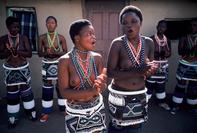
Initiation Amongst Males and Females
Initiation is still practised among both males and females in Ndebele society, marking the passage from childhood to adult status. At the conclusion of the rites, the initiate is allowed to become sexually active and to begin the protracted process of engagement and marriage.
An important function of initiation is to bond age groups together, and to distinguish them from other age groups. Male initiates 'abakhethua' are impressed upon to associate only with other men who have gone through the initiation process.
In order to ensure the exclusivity and elitism of initiation, the abakhethua are instructed not to reveal to uninitiated boys what happens during the seclusion in the initiation lodge 'umphadu'.
Through the process of initiation, males and females are inducted into traditional lore and the deep mysteries of the group. This knowledge is passed on from one generation of initiates to the next, ensuring that the transfer of knowledge is maintained, and the cultural solidarity of the group reinforced.
Male Initiation

Male initiation 'wela or ingoma' is conducted among the Ndzundza Ndebele roughly every four years, and the boys are usually 15 to 18 years old. Their names have to be registered with the paramount chief 'king'. Once this is done and the chief has set a date, the initiate dons a grass headband 'isonyana', which indicates that he is an initiate in preparation.
At this stage, he performs various ritual tasks for three weeks. Before leaving for the chief's residence, where the abakhethua from nearby homesteads meet, each is given an isititirimba - loincloth, from the Afrikaans stertriem, made for them by their grandfathers from an animal skin, and a single, often threadbare, blanket, despite the fact that initiation usually takes place during the coldest part of winter.
At the chief's residence, the initiates conduct rituals, symbolically bidding farewell to their boyhood. After this, they are taken to the chief's cattle enclosure. At dawn, they are woken and taken down to a sacred place at a nearby river. They are dispersed along the river bank, and circumcised. From here they have to cross the river 'ukuwela' and march with downcast eyes under escort to different initiation lodges, depending on their village of origin.
The initiates remain in the lodges, deep in the bush, for two months, being instructed on the lore of the group and their responsibilities, duties and rights as men. After their period of seclusion, feasts are prepared at the abakhethua's homes, and the presents they receive from family members, to celebrate the attainment of manhood, are displayed.
When the abakhethua leave the umphadu, it is set alight with the blankets and garments they wore during initiation, signifying the completion of their rites of passage and the closing of a chapter in their lives. After this, they return at sunset to the chief's residence, tightly wrapped in new blankets, with their eyes downcast in an obvious display of humility, similar to when they departed for the initiation lodge. Beneath their blankets the boys are naked with the exception of the isititirimba, which symbolizes manhood.
That night they sleep in the enclosure and at dawn the next morning all initiates are publicly paraded 'ukupalala' and officially receive their regimental names from the chief. After this, the members of the group return to their homes and a long round of celebrations. The next stage in the young men's lives opens up as the process of engagement and marriage is contemplated, during which they are allowed to indulge in restricted sexual intercourse.
Female Initiation

Female initiation 'iqhude or ukuthombisa' is less painful than male initiation, as no clitoridectomy or body mutilations are performed. The process begins once the girl has reached puberty, starting the morning before the first full moon, when the girls are stripped naked and symbolically returned to nature, by having all the hair on their bodies shaved off.
Each initiate is attended by appointed guides — older girls and women who have been initiated. Once the girls are prepared, the rest of the day is spent singing and dancing to the accompaniment of a drum-like instrument, from which a twanging sound is produced. In the evening, the girls gather around a fire, wearing a blanket given to them for initiation, while the guides are stripped naked.
They sing songs before launching into a tirade of abuse and cursing against males, the concept of masculinity and male sexual organs, and women who have not been initiated. This ritual abuse lasts throughout the night. Early the next morning, the initiates and their guides go to a river, where the former are ritually washed, after which they return to their homesteads.
The next day a celebration is held and the initiate is again washed. She then goes into seclusion in a specially constructed room in her own home. In earlier times the period of seclusion was three months, but today, with the demands of schooling and employment, it has been reduced to one month. During this time, the initiate receives instruction from her guides.
She is also visited by the grandmothers of the homestead, who instruct her on lore and customs, as well as her duties and responsibilities. The main point of initiation, however, is to instruct the initiate on the duties and practices of home-making.
During her seclusion, she is not allowed to talk to or see any males, and thus she performs the domestic duties she is taught during initiation at night or in the early hours of the morning. At the end of the seclusion, the initiate is taken to the river for a final washing. Her initiation blanket and clothes are burnt, symbolizing the 'death' of girlhood.
She is given an isiphephetu, a stiff beaded apron, as a sign of her ascent from girlhood to womanhood. As with male initiation the changed status of the initiate is celebrated with communal feasting in succession at the homes of all the girls who underwent initiation. This is a time of joy, during which the newly initiated women are able to flirt and attract the attention of a potential husband.
 The Ndebele history includes the middle of the 19th century, the Kekana faction of the Ndebele tribe had further divided into smaller splint...
The Ndebele history includes the middle of the 19th century, the Kekana faction of the Ndebele tribe had further divided into smaller splint... South Africa is home to a wide array of vibrant, rich cultures, each with their own deep history. SouthAfrica.co.za tells the stories of the...
South Africa is home to a wide array of vibrant, rich cultures, each with their own deep history. SouthAfrica.co.za tells the stories of the...